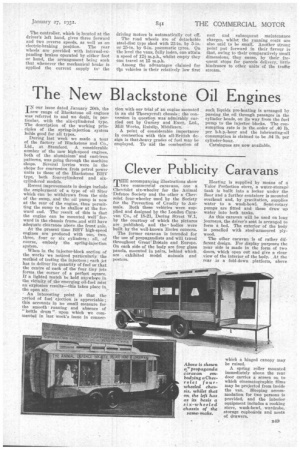The New B1 a ckstone Oil Engines I N our issue
Page 67

If you've noticed an error in this article please click here to report it so we can fix it.
dated .January 20th, the new range of Blackstone oil engines was referred to and we dealt, in particular, with the six-cylindered type. The description of the working principles of the spring-injection system holds good for all types.
During last week we made a tour of the factory of Blackstone and Cp., Ltd., at Stamford. A considerable nUmber of the new high-speed engines, both of the aluminium and cast-iron patterns, was going through the machine shops. Several lorries were in the 8hops ' for conversion from petrol power units to those of the Blackstone BLIV type, both four-cYlindered and sixcylindered models.
• Recent improvements in design include the employment of a type of oil Alter which can be withdrawn from the side of the sump, and the oil pump is now at the rear of the engine, thus permitting the sump to be shallow at the forward end. The result of this is that the engine can be mounted well forward in the chassis frame.aml still have adequate clearance above the front axle.
At the present time BHV high-speed engines are produced with one, two, three, four or six cylinders: all, of course, embody the sprihg-injection system.
When in the injector-block section of the works we noticed particularly the method of testing the injectors ; each jet has to deliver its quantity of fuel sothat the centre of each of the four tiny jets forms the corner of a perfect square. If a lighted match *be held anywhere in the vicinity of the emerging oil-fuel mist an explosion residts—this takes place in the open air.
An interesting point is that theperiod of fuel ejection is appreciable ; this accounts in no • small measure for the smooth • running and absence of "kettle drum ".• upon which we commentid in last week's issue in connec
tion with our trial of an engine Mounted . in an old Thornycroft chassis ; the conversion in question was admirably carried out by Gurney and Ewer, Ltd., Mill Works, Ruislip, Middlesex.
A point of considerable importance in connection with this all-British design is thatdieavy grades of fuel may be employed. To • aid the combustion of such liquids pre-heating is arranged by passing the oil through passages in the cylinder heads, on its way from the fuel pump to the injector blocks. The consumption rate is in the order of .46 lb. per b.h.p.-hour and the lubricating-oil consumption is claimed to be .04 lb. per cylinder-hour.
Catalogues are now available.




































































































